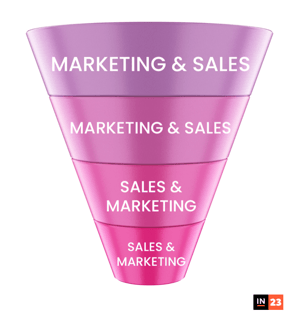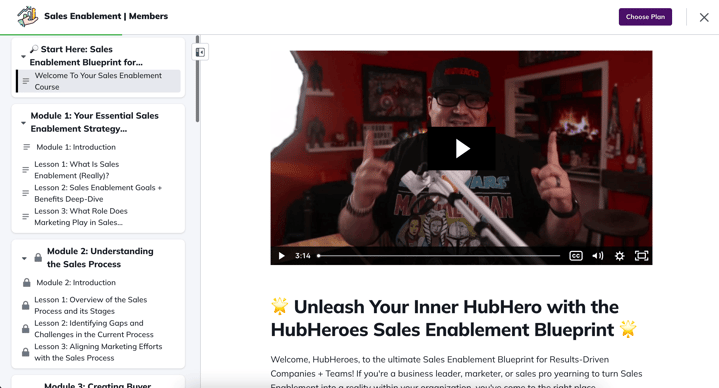5 min read
Here's Why Your Sales Enablement Strategy Is Broken (+ New Sales Enablement Course)
 George B. Thomas
Sep 6, 2023 2:55:54 PM
George B. Thomas
Sep 6, 2023 2:55:54 PM
Rather listen to this post?
Howdy, folks! I am thrilled right now for two reasons. First, I am coming to you live today from center of the HubSpot universe, #INBOUND23 in Boston ...

Why yes, that is a new HubHeroes podcast lid, thanks for noticing! 😎
Second, this week at INBOUND, I'm speaking on stage about the the six no-bs reasons why your sales enablement strategy is failing.
But since I know not everyone will be able to join in the INBOUND festivities here in Boston this week, I wanted to share a brand new sales enablement resource I'm announcing exclusively here at INBOUND this week!
But first, let's talk about what's broken with sales enablement ...
Here's why most sales enablement strategies fail
"Sales enablement" is probably one of the hottest buzz phrases in the entire inbound ecosystem. Yet so few organizations seem to make their sales enablement dreams a reality — even with the best of intentions.
Why is that? Well, while there is no single "one point of failure to rule them all" with sales enablement, I have noticed a pattern.
In working with hundreds of organizations over the years, I've observed there are six surprisingly common reasons why even the most committed, HubSpot-lovin', inbound-rockin' teams will stumble when it comes to getting a stable, revenue-generating sales enablement strategy off the ground.
1. Faulty beliefs and costly mindsets
If you begin your journey with sales enablement believing it’s overwhelming, way too hard, and just a bunch of overblown hype, it doesn’t matter what strategies or tactics you deploy. You’re going to stunt your potential for sales enablement before you get your new strategy off the ground.
So, your journey begins by shifting your mindset to sales enablement helping everyone be heard — it’s all about being helpful and human! That means you need to go beyond just providing information and tools to your sales team. It's about creating an environment where every individual, from the top executives to the newest sales reps, feels empowered to contribute their unique perspectives and insights.
🎓 Online course: Sales Enablement Strategy Blueprint for ROI-driving Teams
But wait, there's more! Being helpful and human in your sales enablement efforts means understanding and empathizing with your customers — that's right, it's not just about the teams under your roof!
When it comes to your sales enablement strategy, you need to focus on building authentic relationships and providing genuine value, internally and externally. It's not just about pushing for sales numbers, but about nurturing long-term partnerships based on trust and mutual success.
2. Split funnel instead of a full funnel
Gone are the days when the marketing and sales funnels were neatly separated. In today's business landscape, the lines between the two have blurred, and the responsibilities of each team have become more intertwined than ever before.
🔎 Related: HubSpot Sales Enablement Tactics and Strategies (HubHeroes Podcast)
With the rise of inbound marketing and the emphasis on creating valuable content, marketing teams are no longer focused solely on lead generation. They are actively involved in nurturing leads and guiding them through the sales funnel.
That means the once split funnel, where marketing owned the top and sales owned the bottom should be traded in for a shared full funnel approach that looks more like this:

This shift in approach has proven to be highly effective, as it allows for a seamless transition from attracting prospects to converting them into customers. But it requires everyone — leadership, marketing, and sales — to come together as one team with one dream ... no more playing hot potato with who is responsible for what!
3. Failing to Solve for (or Totally Faking) the Curiosity Gap
The Curiosity Gap is a fascinating concept that plays a crucial role in sales enablement. It represents the space between the information we already possess and the information that is deliberately kept hidden. As content creators and marketers, we need to bridge this gap with authenticity and finesse ... and that's admittedly easier said than done!
🔎 Related: HubSpot Playbooks Deep-Dive for Sales Enablement (HubHeroes Podcast)
On one hand, we want to provide our customers with enough information to pique their interest and engage them in a meaningful way. On the other hand, we don't want to reveal everything upfront in our content, as it can diminish the intrigue and curiosity that drives them to learn more. So, what do we do?
Authenticity is key in this process. We must ensure that the information we share is accurate, reliable, and aligns with our expertise. By doing so, we establish trust with our customers and demonstrate that we truly understand our subject matter. But we also need to avoid the temptation of faking knowledge or overpromising what we can deliver.
4. No Content Success Champion 🙁
You likely are already killing it with content wins that are contributing to sales success … but does the rest of your team know? Most organizations are failing in this critical area — they're racking up wins with truly sales enabling content, but no one knows about it!
This is content marketing ROI 101, folks. Without you investing in the proper communication and recognition of the value your content is bringing to the sales process, your organization is missing out on the opportunity to leverage and amplify its success, in addition to celebrating it.
🎧 Related HubHeroes Episodes + Resources:
- How to Measure Content Marketing ROI the Right Way
- HubSpot Reporting + Analytics Deep-Dive with Jorie Munroe
- George's Totally Dope Insider's Guide to HubSpot Reporting
To address this issue, it's crucial to establish a culture of collaboration and knowledge sharing within the organization. Regular meetings or updates can be held to showcase the content wins and discuss how they can be leveraged in the sales process.
This not only keeps the entire team informed but also creates a sense of excitement and motivation around the content initiatives. Stepping into the limelight within your organization as the sales enablement content champion is essential to keeping everyone engaged, excited, and enabled.
5. Broken Promises and Eroded Trust
Often the #1 reason why a sales enablement initiative fails within an organization is because of a pre-existing lack of trust between teams – particularly marketing and sales. Even with the best of intentions, this can happen, so you need to make the discovery and repair of trust issues a high priority at the start of your journey.
Trust is the foundation of any successful relationship, and the same goes for the relationship between marketing and sales teams. When there is a lack of trust, it can lead to miscommunication, finger-pointing, and a breakdown in collaboration. Sales reps may feel that marketing is not providing them with quality leads, while marketers may feel that sales is not effectively following up on their leads.
🎓 Online course: Sales Enablement Strategy Blueprint for ROI-Driving Teams
Lack of trust can create a toxic environment that can totally kill any chance of success you could achieve with your sales enablement strategy. To address this, your marketing and sales folks have to come together to have a candid discussion about their concerns and expectations.
This is one of the most challenging sales enablement challenges organizations face, but it cannot be overlooked. It's also totally possible for your people to come together to repair any broken trust. Does it take time? Yes. But I've seen myself how unstoppable organizations can become when they make the effort.
6. You Don't Have a Revenue Team
As we discussed already, your marketing and sales teams are more blended with their responsibilities than ever before across the funnel.
So, instead of treating them as two siloed teams, you should embrace the revenue team model. Yes, your marketing and sales folks are still responsible for different things, but this revenue team model will enable you all to stay on the same page as one team with one dream.
🔎 Related: Why Your Sales Enablement Strategy Is Failing (HubHeroes Podcast)
A revenue team is a group of individuals within a company who are responsible for generating revenue through sales and marketing activities. Revenue teams typically include members from various departments (primarily marketing and sales), and often work on lead generation, lead nurturing, improved conversion rates, and revenue growth.
Sales Enablement Strategy Blueprint (NEW COURSE)
In addition to many of the goodies I am sharing with my #INBOUND23 audience (which you can access here!), the crown jewel of my new sales enablement toolkit is ...
⭐ NEW ONLINE COURSE ⭐
Sales Enablement Blueprint for Results-Driven Companies + Teams
This comprehensive online course — an EXCLUSIVE for premium HubHeroes Community members — is designed for business leaders and owners, marketing pros, and sales all-stars who are ready to be the sales enablement HubHero their company needs.
Everyone in your organization plays a vital role in the successful development and deployment of a sales enablement strategy. That’s why this course is designed to help more than just one group of amazing, sales enabling humans.
Over 10 comprehensive modules, you'll unlock the HubHero secrets to crafting a winning sales enablement strategy your entire company will get behind with enthusiasm ... because the results are undeniable.
See Y'all After INBOUND 👋
Holy moly, the updates they've already dropped in the first day and a half will blow your freakin' mind open 🤯. I cannot wait to share what I've learned during my time here. Trust me when I say our HubHeroes Podcast #INBOUND23 Recap Episode is going to be one for the history books!
But until then, check out the HubHeroes community and explore the sales enablement course. They were built just for you, the fearless humans chasing after inbound glory.





